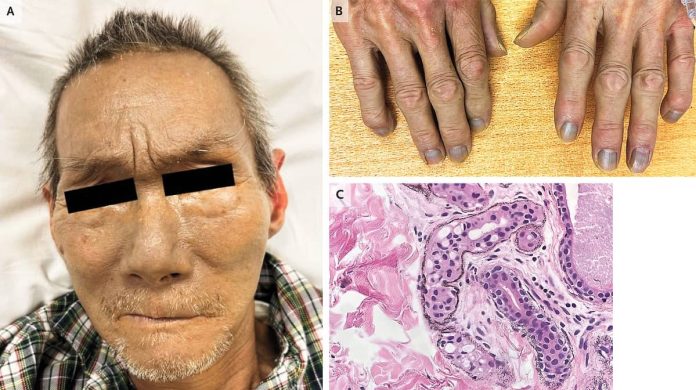
In Hong Kong, an 84-year-old man checked into the hospital for a routine condition tied to an enlarged prostate. But doctors quickly noticed something extraordinary about him—his skin had an unusual grayish hue. His face, fingernails, and even the whites of his eyes displayed a silvery tint, an observation that led to a diagnosis of a rare medical condition: generalized argyria.
The Mystery of the Gray Hue
Argyria is a condition caused by excessive buildup of silver in the body, which deposits in tissues and leads to a blue-gray discoloration of the skin. In this case, a skin biopsy revealed tiny dark granules of silver embedded in the man’s skin fibers, blood vessels, sweat gland membranes, and hair follicles. A blood test confirmed the diagnosis, showing silver levels in his bloodstream at 423 nmol/L—over 40 times the normal limit of less than 10 nmol/L.
The discoloration was particularly striking on his face, a hallmark of argyria due to its exposure to sunlight. Ultraviolet (UV) light plays a role in this phenomenon, triggering photoreduction of silver ions in the skin to form metallic silver. These particles oxidize further into compounds like silver sulfide and silver selenide, deepening the grayish tone. Additionally, silver can stimulate melanin production, compounding the pigmentation.
How Does Silver Build Up?
The journey of silver in the human body begins when it is ingested, absorbed through the gut, and transported via the bloodstream to various tissues. Once deposited, silver is nearly impossible to remove, as therapies like chelation, effective for other metals, do not work on silver. Though laser treatments have shown some promise, discoloration is largely considered permanent.
While silver exposure is not typically life-threatening, severe doses—such as 50 milligrams administered intravenously—can lead to acute toxicity, damaging the liver, kidneys, and bone marrow. However, in most cases, including this one, the condition remains largely cosmetic.
The Elusive Source
A critical question in any case of argyria is the source of silver exposure. Historically, silver was used medicinally to treat infections before antibiotics were developed. In modern times, it is often marketed in colloidal form by naturopathic practitioners, despite no proven health benefits. These solutions are touted as remedies for everything from infections to chronic ailments, but they carry risks.
For instance, an 84-year-old woman in Canada turned gray after consuming a silver solution intermittently over 15 years. Similarly, a 64-year-old man in the UK developed argyria after drinking a liter of colloidal silver water weekly for a year, believing it would prevent infections.
In the Hong Kong man’s case, the source remained a mystery. He denied taking any silver-containing supplements and had no occupational exposure, having worked as a waiter. His only medication was finasteride, used to treat his prostate condition, and none of his neighbors displayed similar symptoms.











